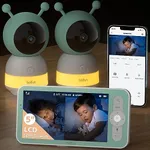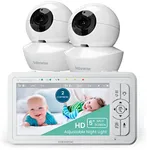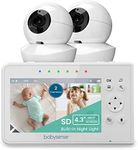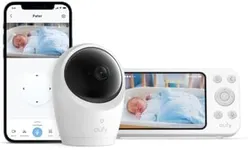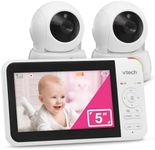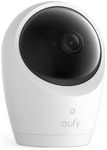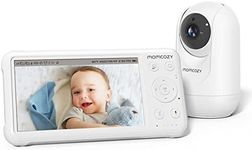Buying Guide for the Best Dual Camera Baby Monitors
Choosing a dual-camera baby monitor can make it much easier to keep an eye on your little ones, especially if you have twins, multiple children, or want to monitor more than one room. The right monitor will give you peace of mind, clear visuals, and reliable performance. To find the best fit, it's important to understand the main features and how they relate to your needs. Think about your home layout, how you plan to use the cameras, and what features will make your daily routine easier and safer.Camera ResolutionCamera resolution refers to how clear and detailed the video image will be. Higher resolution means a sharper picture, which can help you see your baby’s movements and facial expressions more clearly. Most monitors offer standard definition, high definition, or even full HD. If you want to easily spot small details or use the monitor in a larger room, a higher resolution is helpful. For basic monitoring in a small space, standard definition may be enough. Consider how important image clarity is for your peace of mind and choose accordingly.
Night VisionNight vision allows you to see your baby clearly in low light or complete darkness. This is important because babies often sleep in dark rooms, and you’ll want to check on them without turning on the lights. Night vision quality can vary, with some cameras offering a clearer image than others. If you plan to use the monitor mostly at night, look for a model with strong night vision performance. If you only need to monitor during the day, this feature may be less critical.
RangeRange is the maximum distance between the camera and the parent unit (monitor) where the signal remains strong. A longer range is important if you have a large house or want to use the monitor outside, like in the backyard. Shorter ranges are fine for apartments or small homes. Think about where you’ll be using the monitor most often and make sure the range matches your needs so you don’t lose connection.
Split-Screen or Auto-Switch ViewingThis feature determines how you view both cameras on the parent unit. Split-screen lets you see both camera feeds at the same time, while auto-switch cycles between them. Split-screen is useful if you want to monitor two children or rooms simultaneously, while auto-switch is fine if you only need to check in on each room periodically. Consider how closely you want to watch both areas and pick the viewing style that matches your routine.
Audio FeaturesAudio features include two-way talk (letting you speak to your baby through the monitor) and sound sensitivity (how well the monitor picks up quiet noises). Two-way talk is helpful for soothing your baby without entering the room, while adjustable sound sensitivity lets you hear only loud cries or every little sound. Decide if you want to interact with your baby remotely or just listen, and choose a monitor with the right audio options for your needs.
Portability and Mounting OptionsPortability refers to how easy it is to move the cameras and monitor around your home, while mounting options include wall mounts, tabletop stands, or clip-ons. If you want to move the cameras between rooms or travel with the monitor, look for lightweight and easy-to-move designs. If you want a permanent setup, check for secure mounting options. Think about your daily routine and whether you need flexibility or a fixed solution.
Battery LifeBattery life is how long the parent unit can operate without being plugged in. Longer battery life means you can carry the monitor around the house without worrying about recharging. If you plan to use the monitor for long periods or overnight, look for a model with extended battery life. If you’ll mostly keep it plugged in, this may be less important.
Privacy and SecurityPrivacy and security refer to how well the monitor protects your video and audio feeds from being accessed by others. Some monitors use encrypted signals or don’t connect to the internet, making them more secure. If you’re concerned about privacy, look for models with strong security features. If you’re less worried, you may prioritize other features instead.

